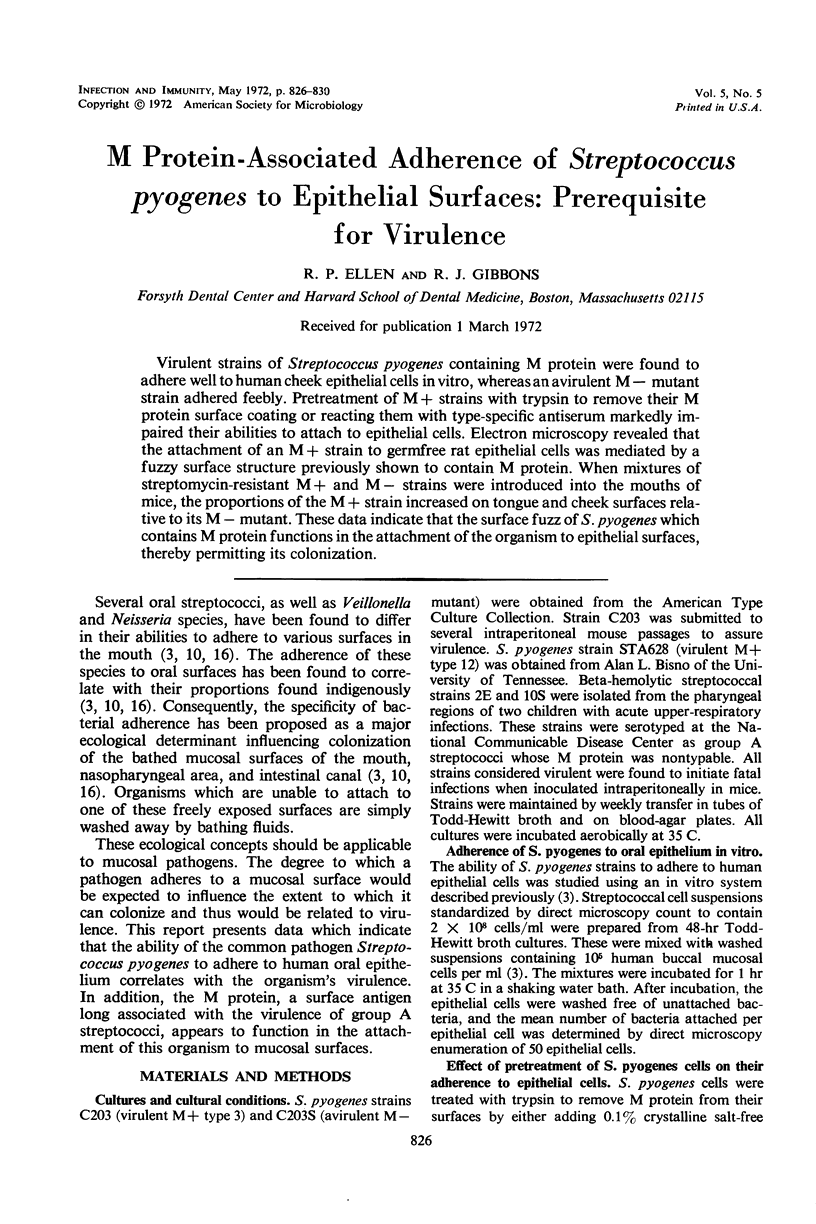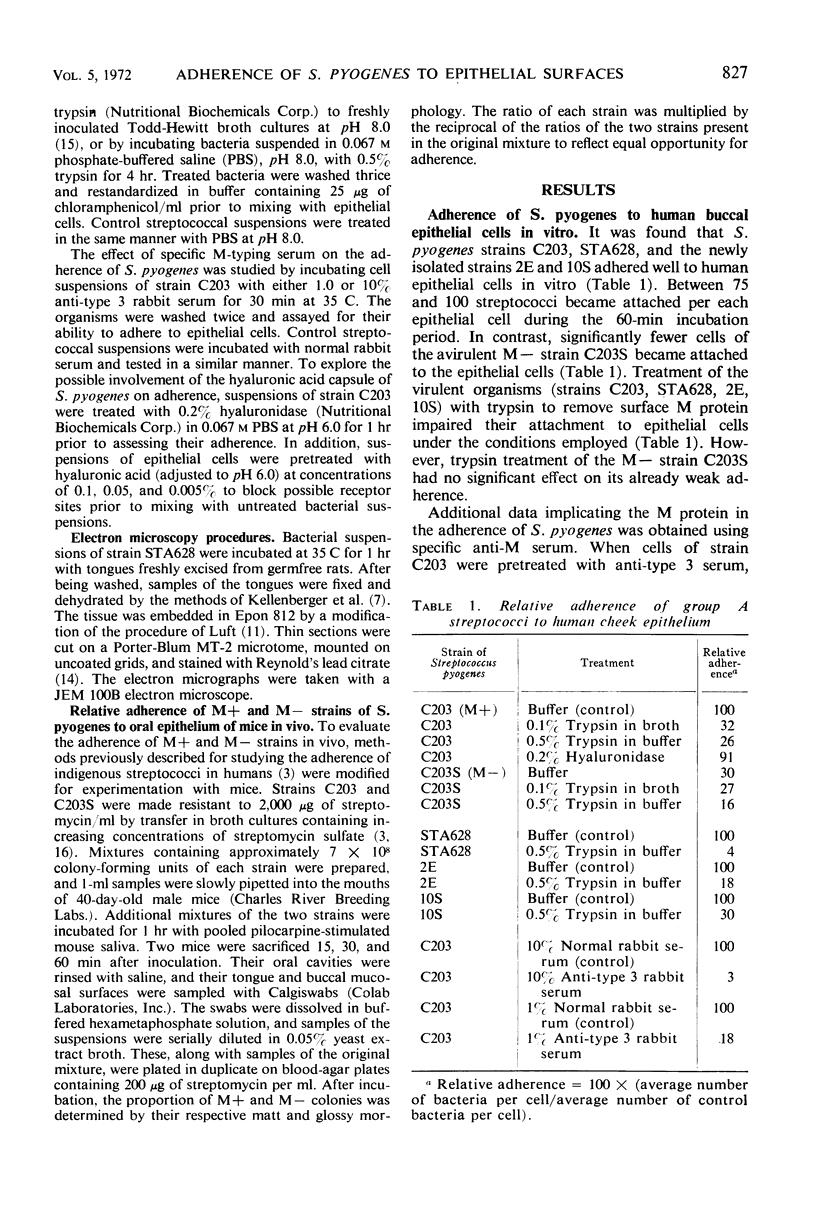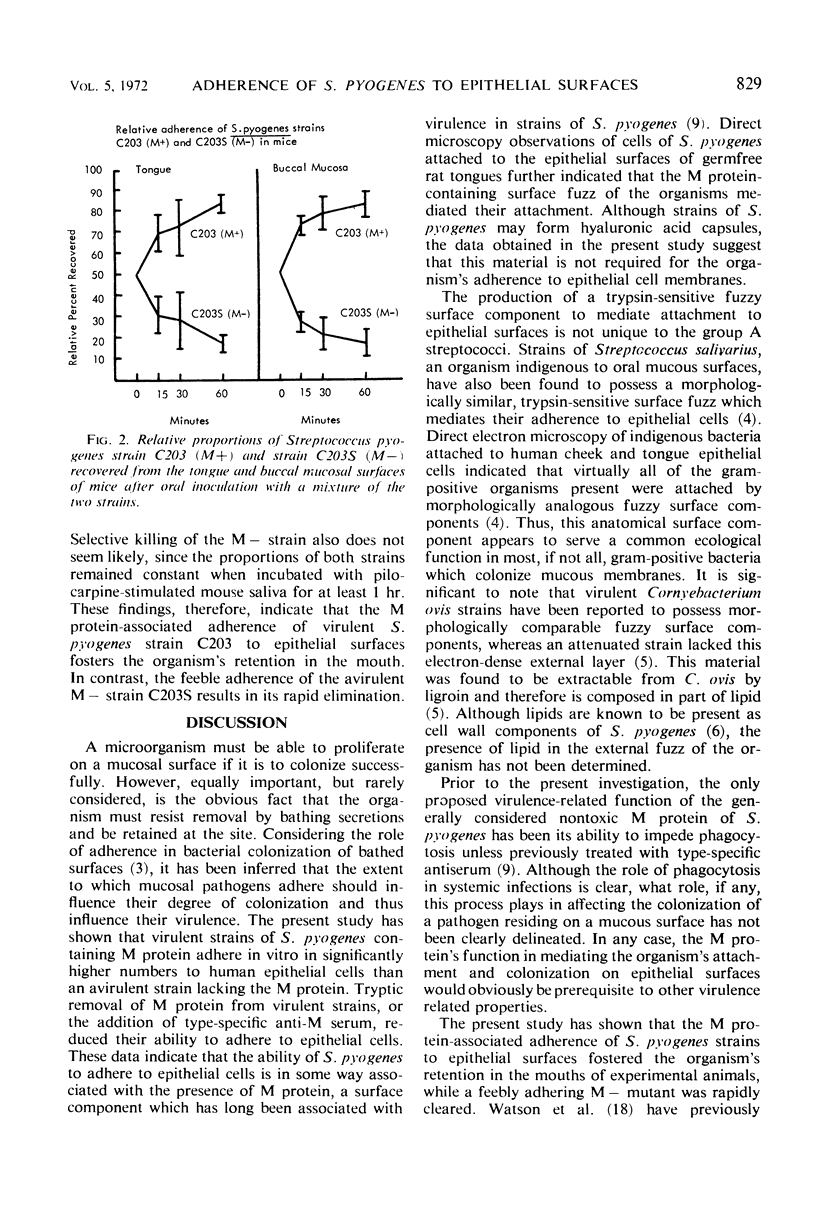Abstract
Virulent strains of Streptococcus pyogenes containing M protein were found to adhere well to human cheek epithelial cells in vitro, whereas an avirulent M − mutant strain adhered feebly. Pretreatment of M + strains with trypsin to remove their M protein surface coating or reacting them with type-specific antiserum markedly impaired their abilities to attach to epithelial cells. Electron microscopy revealed that the attachment of an M + strain to germfree rat epithelial cells was mediated by a fuzzy surface structure previously shown to contain M protein. When mixtures of streptomycin-resistant M + and M − strains were introduced into the mouths of mice, the proportions of the M + strain increased on tongue and cheek surfaces relative to its M − mutant. These data indicate that the surface fuzz of S. pyogenes which contains M protein functions in the attachment of the organism to epithelial surfaces, thereby permitting its colonization.
Full text
PDF




Images in this article
Selected References
These references are in PubMed. This may not be the complete list of references from this article.
- Arbuckle J. B. The location of Escherichia coli in the pig intestine. J Med Microbiol. 1970 May;3(2):333–340. doi: 10.1099/00222615-3-2-333. [DOI] [PubMed] [Google Scholar]
- Drucker M. M., Yeivin R., Sacks T. G. Pathogenesis of Escherichia coli enteritis in the ligated rabbit gut. Isr J Med Sci. 1967 May-Jun;3(3):445–452. [PubMed] [Google Scholar]
- Gibbons R. J., Van Houte J., Liljemark W. F. Parameters that effect the adherence of Streptococcus salivarius to oral epithelial surfaces. J Dent Res. 1972 Mar-Apr;51(2):424–435. doi: 10.1177/00220345720510023101. [DOI] [PubMed] [Google Scholar]
- Gibbons R. J., van Houte J. Selective bacterial adherence to oral epithelial surfaces and its role as an ecological determinant. Infect Immun. 1971 Apr;3(4):567–573. doi: 10.1128/iai.3.4.567-573.1971. [DOI] [PMC free article] [PubMed] [Google Scholar]
- HILL M. J., JAMES A. M., MAXTED W. R. SOME PHYSICAL INVESTIGATIONS OF THE BEHAVIOUR OF BACTERIAL SURFACES. X. THE OCCURRENCE OF LIPID IN THE STREPTOCOCCAL CELL WALL. Biochim Biophys Acta. 1963 Nov 29;75:414–424. doi: 10.1016/0006-3002(63)90629-2. [DOI] [PubMed] [Google Scholar]
- Hard G. C. Electron microscopic examination of Corynebacterium ovis. J Bacteriol. 1969 Mar;97(3):1480–1485. doi: 10.1128/jb.97.3.1480-1485.1969. [DOI] [PMC free article] [PubMed] [Google Scholar]
- KELLENBERGER E., RYTER A., SECHAUD J. Electron microscope study of DNA-containing plasms. II. Vegetative and mature phage DNA as compared with normal bacterial nucleoids in different physiological states. J Biophys Biochem Cytol. 1958 Nov 25;4(6):671–678. doi: 10.1083/jcb.4.6.671. [DOI] [PMC free article] [PubMed] [Google Scholar]
- LANCEFIELD R. C. Current knowledge of type-specific M antigens of group A streptococci. J Immunol. 1962 Sep;89:307–313. [PubMed] [Google Scholar]
- LUFT J. H. Improvements in epoxy resin embedding methods. J Biophys Biochem Cytol. 1961 Feb;9:409–414. doi: 10.1083/jcb.9.2.409. [DOI] [PMC free article] [PubMed] [Google Scholar]
- Labrec E. H., Schneider H., Magnani T. J., Formal S. B. EPITHELIAL CELL PENETRATION AS AN ESSENTIAL STEP IN THE PATHOGENESIS OF BACILLARY DYSENTERY. J Bacteriol. 1964 Nov;88(5):1503–1518. doi: 10.1128/jb.88.5.1503-1518.1964. [DOI] [PMC free article] [PubMed] [Google Scholar]
- Liljemark W. F., Gibbons R. J. Ability of Veillonella and Neisseria species to attach to oral surfaces and their proportions present indigenously. Infect Immun. 1971 Sep;4(3):264–268. doi: 10.1128/iai.4.3.264-268.1971. [DOI] [PMC free article] [PubMed] [Google Scholar]
- Mickelson M. N., Slade H. D. Absence of type specific M antigen from group A streptococci grown in a chemically defined medium. J Bacteriol. 1964 May;87(5):1251–1251. doi: 10.1128/jb.87.5.1251-.1964. [DOI] [PMC free article] [PubMed] [Google Scholar]
- Punyashthiti K., Finkelstein R. A. Enteropathogenicity of Escherichia coli. I. Evaluation of mouse intestinal loops. Infect Immun. 1971 Oct;4(4):473–478. doi: 10.1128/iai.4.4.473-478.1971. [DOI] [PMC free article] [PubMed] [Google Scholar]
- REYNOLDS E. S. The use of lead citrate at high pH as an electron-opaque stain in electron microscopy. J Cell Biol. 1963 Apr;17:208–212. doi: 10.1083/jcb.17.1.208. [DOI] [PMC free article] [PubMed] [Google Scholar]
- Swanson J., Hsu K. C., Gotschlich E. C. Electron microscopic studies on streptococci. I. M antigen. J Exp Med. 1969 Nov 1;130(5):1063–1091. doi: 10.1084/jem.130.5.1063. [DOI] [PMC free article] [PubMed] [Google Scholar]
- Van Houte J., Gibbons R. J., Pulkkinen A. J. Adherence as an ecological determinant for streptococci in the human mouth. Arch Oral Biol. 1971 Oct;16(10):1131–1141. doi: 10.1016/0003-9969(71)90042-2. [DOI] [PubMed] [Google Scholar]
- Wannamaker L. W. Group A Streptococcus. Zentralbl Bakteriol Orig. 1970;214(3):293–297. [PubMed] [Google Scholar]



